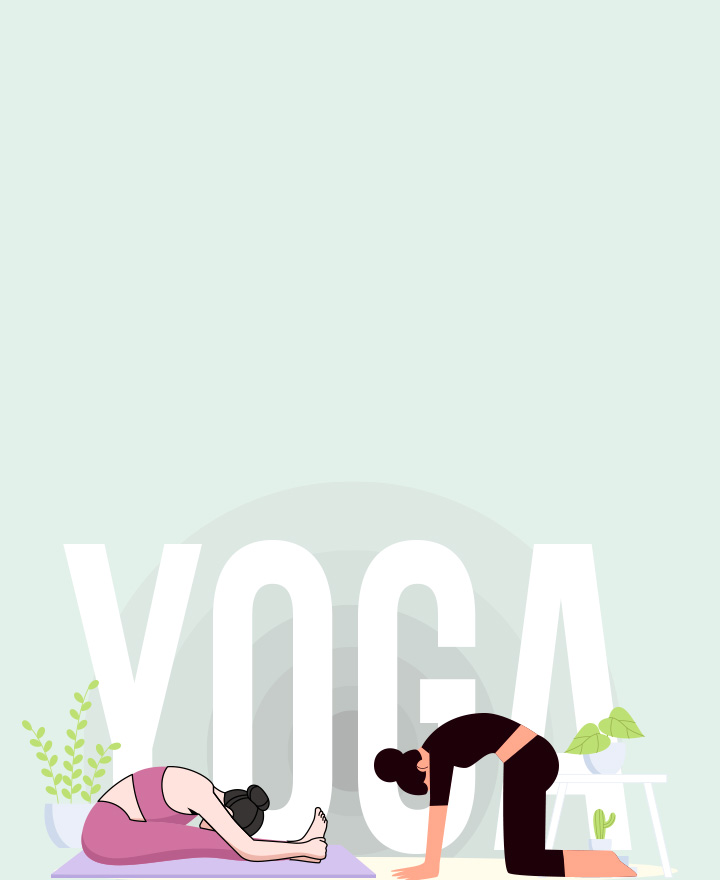

Restorative Yoga Postures: Calm your Body and Mind
After a harried day where you had to rush through a pile of files to meet deadlines or run around completing errands, how about a restorative yoga session to help you relax and rejuvenate? Restorative yoga is intended for relaxation and is well-suited for practising after a hectic day. With help of props and holding certain poses for extended periods, one can liberate his/her mind and find a state of perfect harmony. Here, we will discuss some important tips, some frequently used props in restorative yoga, and certain effective poses to relax your body and mind.
Essential Tips for Practising
1. Create the Ambience:
Make sure the room is at a comfortable temperature along with dim lighting and soothing music. This assists in notifying the body and brain that it is okay to rest.
2. Make Use of Props:
The basis of restorative yoga poses is a prop. A prop supports the body and makes it possible to hold certain poses without experiencing significant discomfort.
3. Focus on Your Breath:
Breathing techniques with a slow and deep rhythm aid in relaxation. Remember to close your eyes and focus on your breath during each asana.
4. Stay Warm:
Since restorative yoga postures are nearly still, it is necessary to warm up before each posture.
Common Props Used
Props are central to how restorative yoga practices are done, as they assist you in maintaining comfort in each posture. Some common props you can use are listed below.
• Bolsters —
Firm cushions that support various poses
• Blankets —
Provide additional cushion and warmth
• Blocks —
Bring the floor closer to you, lowering the difficulty of poses
• Straps —
Help sustain stretches without muscle strain
Top Restorative Yoga Postures
1. Child's Pose (Balasana):
By moving forward and bending slightly, you can relax back and shoulder muscles. Lay a bolster beneath the upper region of your body as cervical support.
2. Reclining Bound Angle Pose (Supta Baddha Konasana):
This pose is suitable for relaxing and opening the hips and chest muscles. Place your knees on blocks or blankets if this is comfortable for you.
3. Supported Bridge Pose (Setu Bandhasana):
Put a small pillow or folded towel behind your lower back to provide support. This stance helps to expand the chest and spine muscles.
4. Savasana (Corpse Pose):
You need to lie down on your back with your arms extended to the side of your body with minimal movement; use a blanket for comfort.
Conclusion
Practising restorative yoga postures can be fulfilling and relaxing as this practice is more passive than other types of yoga asanas. A calming environment can be created with the right setup, appropriate props, and long, gentle holds. Try these poses and notice the changes in your body and mind.
One of the important components of our overall wellness is also being financially secured. Healthcare emergencies can happen any time, but a good health insurance policy can protect you from such uncertain situations. To know more about Wellness and other health related tips, visit the wellness corner.
Source: healthline.com, yogajournal.com
Disclaimer: This blog provides general information and discussions about health and related subjects. The information and other content provided in this blog, website or in any linked materials are not intended and should not be considered, or used as a substitute for, medical advice, diagnosis or treatment. Kindly contact your Doctor before starting a new medicine or health regime.
Related Articles
Yoga Asana - The Key To A Calmer Mind And Stress-Free Body
6 Yogasanas To Do At Home To Help Relax Your Mind
5 Yoga Asanas To Improve Memory And Concentration
How Yoga Can Improve Your Health
Published on July 26, 2024














 Health Insurance
Health Insurance  Travel Insurance
Travel Insurance  Car Insurance
Car Insurance  Cyber Insurance
Cyber Insurance  Critical Illness Insurance
Critical Illness Insurance
 Pet Insurance
Pet Insurance
 Bike/Two Wheeler Insurance
Bike/Two Wheeler Insurance  Home Insurance
Home Insurance  Third Party Vehicle Ins.
Third Party Vehicle Ins.  Tractor Insurance
Tractor Insurance  Goods Carrying Vehicle Ins.
Goods Carrying Vehicle Ins.  Passenger Carrying Vehicle Ins.
Passenger Carrying Vehicle Ins.  Compulsory Personal Accident Insurance
Compulsory Personal Accident Insurance  Travel Insurance
Travel Insurance  Rural
Rural